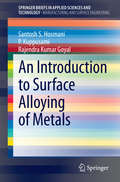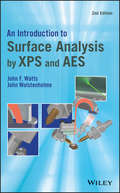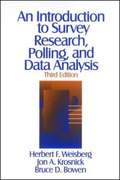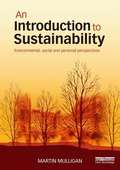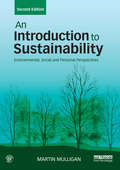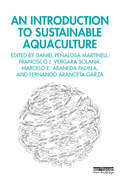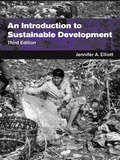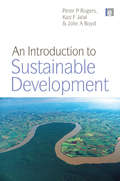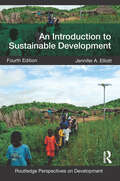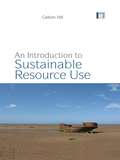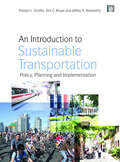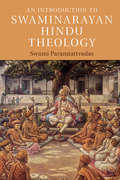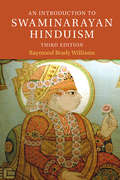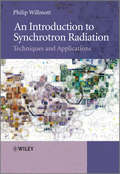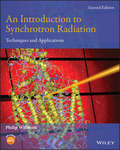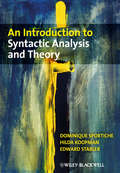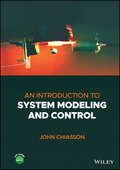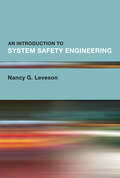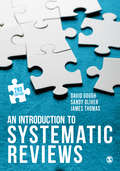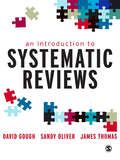- Table View
- List View
An Introduction to Support Vector Machines: and other kernel-based learning methods
by John Shawe-Taylor Nello CristianiniThis is the first comprehensive introduction to Support Vector Machines (SVMs), a new generation learning system based on recent advances in statistical learning theory. Students will find the book both stimulating and accessible, while practitioners will be guided smoothly through the material required for a good grasp of the theory and its applications. The concepts are introduced gradually in accessible and self-contained stages, while the presentation is rigorous and thorough. Pointers to relevant literature and web sites containing software make it an ideal starting point for further study.
An Introduction to Supporting People with a Learning Disability
by Liz Tilly Elaine HardieIf you work with people with a learning disability and are studying for a health and social care qualification, or you want the right information to help your personal development, then An introduction to supporting people with a learning disability is for you. This book puts the person at the centre of the support you give. It uses real life stories, activities and thinking points to cover all of the learning outcomes and is full of practical examples of how to apply the ideas to the support you provide.
An Introduction to Surface Alloying of Metals (SpringerBriefs in Applied Sciences and Technology)
by Santosh S. Hosmani P. Kuppusami Rajendra Kumar GoyalAn Introduction to Surface Alloying of Metals aims to serve as a primer to the basic aspects of surface alloying of metals. The book serves to elucidate fundamentals of surface modification and their engineering applications. The book starts with basics of surface alloying and goes on to cover key surface alloying methods, such as carburizing, nitriding, chromizing, duplex treatment and the characterization of surface layers. The book will prove useful to students at both the undergraduate and graduate levels, as also to researchers and practitioners looking for a quick introduction to surface alloying.
An Introduction to Surface Analysis by XPS and AES
by John F. Watts John WolstenholmeProvides a concise yet comprehensive introduction to XPS and AES techniques in surface analysis This accessible second edition of the bestselling book, An Introduction to Surface Analysis by XPS and AES, 2nd Edition explores the basic principles and applications of X-ray Photoelectron Spectroscopy (XPS) and Auger Electron Spectroscopy (AES) techniques. It starts with an examination of the basic concepts of electron spectroscopy and electron spectrometer design, followed by a qualitative and quantitative interpretation of the electron spectrum. Chapters examine recent innovations in instrument design and key applications in metallurgy, biomaterials, and electronics. Practical and concise, it includes compositional depth profiling; multi-technique analysis; and everything about samples—including their handling, preparation, stability, and more. Topics discussed in more depth include peak fitting, energy loss background analysis, multi-technique analysis, and multi-technique profiling. The book finishes with chapters on applications of electron spectroscopy in materials science and the comparison of XPS and AES with other analytical techniques. Extensively revised and updated with new material on NAPXPS, twin anode monochromators, gas cluster ion sources, valence band spectra, hydrogen detection, and quantification Explores key spectroscopic techniques in surface analysis Provides descriptions of latest instruments and techniques Includes a detailed glossary of key surface analysis terms Features an extensive bibliography of key references and additional reading Uses a non-theoretical style to appeal to industrial surface analysis sectors An Introduction to Surface Analysis by XPS and AES, 2nd Edition is an excellent introductory text for undergraduates, first-year postgraduates, and industrial users of XPS and AES.
An Introduction to Survey Research, Polling, and Data Analysis (3rd edition)
by Herbert F. Weisberg Jon A. Krosnick Bruce D. BowenExplains how surveys are conducted, how to read statistical reports, and how to analyze data, and provides guidelines for evaluating polls. Coverage includes understanding tables, interval statistics, survey design, sampling and question-writing, interviewing and coding strategies, analysis of different types of surveys, and reading and writing reports. Includes chapter exercises and answers. Paper edition (unseen), $25. 95. Annotation c. by Book News, Inc. , Portland, Or.
An Introduction to Sustainability: Environmental, Social and Personal Perspectives
by Martin MulliganAn Introduction to Sustainability provides students with a comprehensive overview of the key concepts and ideas which are encompassed within the growing field of sustainability. The book teases out the diverse but intersecting domains of sustainability and emphasises strategies for action. Aimed at those studying the subject for the first time, it is unique in giving students from different disciplinary backgrounds a coherent framework and set of core principles for applying broad sustainability principles within their personal and professional lives. These include: working to improve equality within and across generations, moving from consumerism to quality of life goals and respecting diversity in both nature and culture. Areas of emerging importance such as the economics of happiness and wellbeing stand alongside core topics including: Energy and society Consumption and consumerism Risk and resilience Waste, water and land. Key challenges and applications are explored through international case studies and each chapter includes a thematic essay drawing on diverse literature to provide an integrated introduction to fundamental issues. Launched with the brand-new Routledge Sustainability Hub, the book's companion website contains a range of features to engage students with the interdisciplinary nature of Sustainability. Together these resources provide a wealth of material for learning, teaching and researching the topic of sustainability. This textbook is an essential companion to any sustainability course.
An Introduction to Sustainability: Environmental, Social and Personal Perspectives
by Martin MulliganAn Introduction to Sustainability provides students with a comprehensive overview of the key concepts and ideas which are encompassed within the growing field of sustainability. The fully updated second edition, including new figures and images, teases out the diverse but intersecting domains of sustainability and emphasises strategies for action. Aimed at those studying the subject for the first time, it is unique in giving students from different disciplinary backgrounds a coherent framework and set of core principles for applying broad sustainability principles within their own personal and professional lives. These include: working to improve equality within and across generations; moving from consumerism to quality of life goals; and respecting diversity in both nature and culture. Areas of emerging importance such as the economics of prosperity and wellbeing stand alongside core topics including: · Energy and society · Consumption and consumerism · Risk and resilience · Waste, water and land. Key challenges and applications are explored through international case studies, and each chapter includes a thematic essay drawing on diverse literature to provide an integrated introduction to fundamental issues. Housed on the Routledge Sustainability Hub, the book’s companion website contains a range of features to engage students with the interdisciplinary nature of sustainability. Together these resources provide a wealth of material for learning, teaching and researching the topic of sustainability. This textbook is an essential companion to any sustainability course.
An Introduction to Sustainable Aquaculture
by Daniel Peñalosa Martinell Vergara-Solana, Francisco J Araneda Padilla, Marcelo E Fernando Aranceta GarzaThis new textbook provides an accessible introduction to sustainable aquaculture through its relationship with three key pillars: the environment, the economy, and society.As the demand for seafood keeps increasing, aquaculture is considered one of the most promising and sustainable ways to satisfy this demand with nutritious and high-quality food. It is important to understand, therefore, the wider role and impact aquaculture has on the environment, the economy, and society. The book begins by providing a foundational introduction to aquaculture and sustainability, discussing the complex and interdependent relationship that exists between the two. The core text of the book is divided into four parts which focus on the environment, economics, social impacts, and governance and technologies. Chapters examine key issues surrounding climate change, food security, new technologies, bioeconomics and risk analysis, international cooperation, employment, and animal welfare, with the book concluding with a chapter examining the future directions and challenges for the aquaculture industry. The book draws on global case studies and each chapter is accompanied by recommended reading and chapter review questions to support student learning.This book will serve as an essential guide for students of aquaculture, fisheries management, and sustainable food, as well as practitioners and policymakers engaged in sustainable fishery development.
An Introduction to Sustainable Development
by Jennifer ElliottThis third edition of a successful, established text provides a concise and well-illustrated introduction to the ideas behind, and the practices flowing from the notion of sustainable development.
An Introduction to Sustainable Development
by Jennifer ElliottThis third edition of a successful, established text provides a concise and well-illustrated introduction to the ideas behind, and the practices flowing from the notion of sustainable development.
An Introduction to Sustainable Development
by Peter P. Rogers Kazi F. Jalal John A. BoydThis volume is the most comprehensive textbook on sustainable development. It has been developed with students and professionals from around the world specifically for those who need a thorough grounding in the subject. Coverage includes: background to sustainable development and global environmental issues; measurement and sustainability indicators; environmental assessment, management and policy; approaches and linkages to poverty reduction; impacts and infrastructure development; economics, consumption, production and market failures; governance; participation; disaster management; international financial institutions; international environmental agreements; and the role of civil society.
An Introduction to Sustainable Development (Routledge Perspectives on Development)
by Jennifer ElliottThis fourth edition has been comprehensively rewritten and updated to provide a concise, well illustrated and accessible introduction to the characteristics, challenges and opportunities of sustainable development with particular reference to developing countries. The contested nature of sustainable development is explored through a detailed consideration of changing ideas and practices within environmentalism and development thinking. The text identifies the different actors involved (from institutions of global governance through to community based organisations), the policies and mechanisms through which sustainable development is being sought and considers the outcomes for particular groups and environments in both rural and urban contexts. ?? This edition places stronger emphasis on the global challenges of sustainable development with an understanding of inter-linked crises in climate, energy, economy, poverty and social injustice. It explores how these issues are leading to deep questioning of what sustainable development is, what it should be, and how sustainable development policies and mechanisms are being reconsidered. The book gives new consideration to the challenge of achieving lower carbon growth, climate adaptation, and the implications on sustainable development of rapidly expanding economies, including China and India. It contains greater discussion of how civil society movements influence outcomes of international climate policy, as well as technological developments in energy and agriculture. The text also contains a substantially expanded discussion of how poverty remains central to sustainable development challenges, as revealed through the Millennium Ecosystem Assessment and Millennium Development Goals. This invaluable text retains the core message that sustainable development has become central to debates about environment and development. Containing a substantial number of new boxed case studies, learning outcomes, chapter summaries, discussion questions, further reading and websites, this text provides an essential introduction for students.
An Introduction to Sustainable Resource Use
by Callum HillThis book explores the challenges our society faces in making the transition to renewable resource use in a way that is truly sustainable – environmentally, economically and socially. After exploring the physical limits the laws of thermodynamics impose on resource exploitation, the book outlines options for managing resources within these limits. It then moves on to look at the resources themselves (from fossil fuels, through minerals to renewable resources such as timber) and the salient question of how the relentless increase in consumption is putting untenable strain on resource use. Case studies investigate what is being done across a range of sectors – and what is and isn't working. The second half of the book turns to solutions, from the promise of industrial ecology to a new economy based on renewable resources such as biobased materials from agricultural crops and forests. Suitable for under- and postgraduate courses on environmental limits and resource use, and continuing professional development – particularly resource management, materials, industrial ecology, energy, resource economics and engineering.
An Introduction to Sustainable Transportation: Policy, Planning and Implementation
by Jeffrey Kenworthy Preston L SchillerCities around the globe struggle to create better and more equitable access to important destinations and services, all the while reducing the energy consumption and environmental impacts of mobility. An Introduction to Sustainable Transportation illustrates a new planning paradigm for sustainable transportation through case studies from around the world with hundreds of valuable resources and references, color photos, graphics and tables. The second edition builds and expands upon the highly acclaimed first edition, with new chapters on urban design and urban, regional and intercity public transportation, as well as expanded chapters on automobile dependence and equity issues; automobile cities and the car culture; the history of sustainable and unsustainable transportation; the interrelatedness of technologies, infrastructure energy and functionalities; and public policy and public participation and exemplary places, people and programs around the globe. Among the many valuable additions are discussions of autonomous vehicles (AVs), electric vehicles (EVs), airport cities, urban fabrics, urban heat island effects and mobility as a service (MaaS). New case studies show global exemplars of sustainable transportation, including several from Asia, a case study of participative and deliberative public involvement, as well as one describing life in the Vauban ecologically planned community of Freiburg, Germany. Students in affiliated sustainability disciplines, planners, policymakers and concerned citizens will find many provides practical techniques to innovate and transform transportation.
An Introduction to Sustainable Transportation: Policy, Planning and Implementation
by Preston L. Schiller Jeffrey R. KenworthyTransportation plays a substantial role in the modern world; it provides tremendous benefits to society, but it also imposes significant economic, social and environmental costs. Sustainable transport planning requires integrating environmental, social, and economic factors in order to develop optimal solutions to our many pressing issues, especially carbon emissions and climate change. This essential multi-authored work reflects a new sustainable transportation planning paradigm. It explores the concepts of sustainable development and sustainable transportation, describes practical techniques for comprehensive evaluation, provides tools for multi-modal transport planning, and presents innovative mobility management solutions to transportation problems. Students of various disciplines, planners, policymakers and concerned citizens will find many of its provocative ideas and approaches of considerable value as they engage in the processes of understanding and changing transportation towards greater sustainability. This text reflects a fundamental change in transportation decision making. It focuses on accessibility rather than mobility, emphasizes the need to expand the range of options and impacts considered in analysis, and provides practical tools to allow planners, policy makers and the general public to determine the best solution to the transportation problems facing a community. The book starts by placing transportation within the broader sustainability discussion, emphasising a comprehensive approach to sustainability planning and introducing the notion of 'regenerative transportation'. In sections on policymaking and planning the book examines how decisions are currently, and how they should be, made - explaining the complex and often misunderstood area of public participation. The authors explain demand management as applied to transportation and present lessons from other public arenas and areas of application, especially in urban-suburban areas. The text takes readers through each and every mode of transport, beginning with human-powered modes and ending in motorized modes, including marine and air transport. The modes are analyzed separately and in comparison with others according to several criteria: Capacity/utility/functionality considerations; infrastructure demands; resource consumption; land use considerations; pollution; and costs. In ways that non-technically trained readers as well as planning students professionals can find useful the book includes guidance on how to optimize transportation systems; balancing economic, social and environmental objectives while creating just, robust, and diverse, rather than one-size-fits-all, solutions. The modes are grouped and compared within their respective contexts, and there is vital discussion and differentiation between passenger and freight-goods transport. The final section develops a comprehensive summary of the previous chapters and develops arguments for sustainable transportation policymaking and integrated planning, providing international examples and case studies and extracting from them general applications for integrated sustainable transportation. Featuring extensive international examples and case-studies, textboxes, graphics, recommended reading and end of chapter questions, the authors draw on considerable teaching and researching experience to present an essential, ground-breaking and authoritative text on sustainable transport.
An Introduction to Swaminarayan Hindu Theology (Introduction to Religion)
by Swami ParamtattvadasSince its inception over two hundred years ago, Swaminarayan Hinduism has flourished into a transnational movement described as one of the fastest growing Hindu groups in the world. Despite being one of the largest and most visible Hindu traditions both in India and the West, surprisingly little is known about what the Swaminarayan fellowship believes. An Introduction to Swaminarayan Hindu Theology provides a comprehensive doctrinal account of the Swaminarayan tradition's belief system, drawing on its rich corpus of theological literature, including the teachings of Swaminarayan himself and classical commentaries on canonical Vedāntic texts. Part I delineates the sources and tools of Swaminarayan Hindu theology, while Part II systematically expounds upon its distinctive five eternal entities - Parabrahman, Akṣarabrahman, māyā, īśvara and jīva - and mukti (spiritual liberation). In presenting these key themes theologically and lucidly, Swami Paramtattvadas makes the Swaminarayan Hindu belief system intelligible to scholars, students and serious readers.
An Introduction to Swaminarayan Hinduism (Introduction to Religion)
by Raymond Brady WilliamsAn Introduction to Swaminarayan Hinduism, third edition, offers a comprehensive study of a contemporary form of Hinduism. Begun as a revival and reform movement in India 200 years ago, it has now become one of the fastest growing and most prominent forms of Hinduism. The Swaminarayan Hindu transnational network of temples and institutions is expanding in India, East Africa, the UK, USA, Australasia, and in other African and Asian cities. The devotion, rituals, and discipline taught by its founder, Sahajanand Swami (1781–1830) and elaborated by current leaders in major festivals, diverse media, and over the Internet, help preserve ethnic and religious identity in many modern cultural and political contexts. Swaminarayan Hinduism, here described through its history, divisions, leaders, theology and practices, provides valuable case studies of contemporary Hinduism, religion, migrants, and transnationalism. This new edition includes up-to-date information about growth, geographic expansion, leadership transitions, and impact of Swaminarayan institutions in India and abroad.
An Introduction to Synchrotron Radiation
by Philip WillmottThis book introduces the reader to the basic concepts of the generation and manipulation of synchrotron light, its interaction with matter, and the application of synchrotron light in the "classical" techniques, while including some of the most modern technological developments. As much as possible, complicated mathematical derivations and formulas are avoided. A more heuristic approach is adopted, whereby the general physical reasoning behind the equations is highlighted.Key features:A general introduction to synchrotron radiation and experimental techniques using synchrotron radiation Contains many detailed "worked examples" from the literature Of interest for a broad audience - synchrotrons are possibly one of the best examples of multidisciplinary research Four-colour presentation throughout
An Introduction to Synchrotron Radiation: Techniques and Applications
by Philip Willmott PhDThe updated guide to the fundamental concepts, techniques and applications of synchrotron radiation and its applications in this rapidly developing field Synchrotron light is recognized as an invaluable research tool by a broad spectrum of scientists, ranging from physicists to biologists and archaeologists. The comprehensively revised second edition of An Introduction to Synchrotron Radiation offers a guide to the basic concepts of the generation and manipulation of synchrotron light, its interaction with matter and the application of synchrotron light in x-ray scattering, spectroscopy, and imaging. The author, a noted expert in the field, reviews the fundamentals of important experimental methods, and explores the most recent technological advances in both the latest generation of x-ray sources and x-ray instrumentation. Designed to be an accessible resource, the book contains full-colour illustrations of the underlying physics and experimental applications, as well as the most commonly-used synchrotron techniques. In particular, the updated second edition now includes: In-depth descriptions of the latest x-ray-source technologies, notably diffraction-limited storage rings and x-ray free-electron lasers The latest advances in instrumentation, x-ray optics, and experimental methods in synchrotron radiation The most recent developments in macromolecular crystallography, time-resolved studies, and imaging techniques A comprehensive set of problems for each chapter, plus their ideal solutions in the appendices. Written for undergraduate and postgraduate students from all areas of the natural and physical sciences, An Introduction to Synchrotron Radiation, Second Edition is an invaluable up-to-date reference source in this highly multidisciplinary field.
An Introduction to Syntactic Analysis and Theory
by Dominique Sportiche Hilda Koopman Edward StablerAn Introduction to Syntactic Analysis and Theory offers beginning students a comprehensive overview of and introduction to our current understanding of the rules and principles that govern the syntax of natural languages. Includes numerous pedagogical features such as ‘practice’ boxes and sidebars, designed to facilitate understanding of both the ‘hows’ and the ‘whys’ of sentence structure Guides readers through syntactic and morphological structures in a progressive manner Takes the mystery out of one of the most crucial aspects of the workings of language – the principles and processes behind the structure of sentences Ideal for students with minimal knowledge of current syntactic research, it progresses in theoretical difficulty from basic ideas and theories to more complex and advanced, up to date concepts in syntactic theory
An Introduction to System Modeling and Control
by John ChiassonA practical and straightforward exploration of the basic tools for the modeling, analysis, and design of control systems In An Introduction to System Modeling and Control, Dr. Chiasson delivers an accessible and intuitive guide to understanding modeling and control for students in electrical, mechanical, and aerospace/aeronautical engineering. The book begins with an introduction to the need for control by describing how an aircraft flies complete with figures illustrating roll, pitch, and yaw control using its ailerons, elevators, and rudder, respectively. The book moves on to rigid body dynamics about a single axis (gears, cart rolling down an incline) and then to modeling DC motors, DC tachometers, and optical encoders. Using the transfer function representation of these dynamic models, PID controllers are introduced as an effective way to track step inputs and reject constant disturbances. It is further shown how any transfer function model can be stabilized using output pole placement and on how two-degree of freedom controllers can be used to eliminate overshoot in step responses. Bode and Nyquist theory are then presented with an emphasis on how they give a quantitative insight into a control system's robustness and sensitivity. An Introduction to System Modeling and Control closes with chapters on modeling an inverted pendulum and a magnetic levitation system, trajectory tracking control using state feedback, and state estimation. In addition the book offers: A complete set of MATLAB/SIMULINK files for examples and problems included in the book. A set of lecture slides for each chapter. A solutions manual with recommended problems to assign. An analysis of the robustness and sensitivity of four different controller designs for an inverted pendulum (cart-pole). Perfect for electrical, mechanical, and aerospace/aeronautical engineering students, An Introduction to System Modeling and Control will also be an invaluable addition to the libraries of practicing engineers.
An Introduction to System Safety Engineering
by Nancy G. LevesonA comprehensive, up-to-date introduction to the foundations of classical safety engineering, with an emphasis on preparing for future challenges.Systems today are orders of magnitude more complex than in the past, and their complexity is increasing exponentially. Preventing accidents and losses in such systems requires a holistic perspective that can accommodate unprecedented types of technology and design. This textbook teaches the foundations of classical safety engineering while incorporating the principles of systems thinking and systems theory. Beginning with the framing and lessons of her classic text, Safeware, Nancy Leveson builds on established knowledge and brings the field up to date, challenging old approaches and introducing new ones. This essential book provides the core information required to build safety-critical systems today and in the future, including coverage of the historical and legal frameworks in which the field operates as well as discussions of risk, ethics, and policy implications. Presents cutting-edge concepts anticipating the safety challenges of the future alongside thorough treatment of historical practices and ideasProvides a comprehensive introduction to the foundations of safety engineeringCovers accident analysis, hazard analysis, design for safety, human factors, management, and operationsIncorporates extensive examples of real-world accidents and applications Ideal for students new to safety engineering as well as professionals looking to keep pace with a rapidly changing field
An Introduction to Systematic Reviews
by James Thomas Sandy Oliver David GoughFocused on actively using systematic review as method, this book provides clear, step-by-step advice on the logic and processes of systematic reviewing. Stressing the importance of precision and accuracy, this new edition carefully balances a need for insightful theory with real-world pragmatism; it introduces a wide range of cutting-edge approaches to research synthesis including text mining, living reviews and new ideas in mixed methods reviews such as qualitative comparative analysis. The book also includes: A new chapter on statistical synthesis Coverage of computer-assisted methods and relevant software Expanded sections on data extraction and management A guide to working with many different types of data including longitudinal and panel. Packed with examples from across the social sciences, this book helps students and researchers alike in turning systematic reviews into recommendations for policy and practice.
An Introduction to Systematic Reviews
by James Thomas Sandy Oliver David GoughFocused on actively using systematic review as method, this book provides clear, step-by-step advice on the logic and processes of systematic reviewing. Stressing the importance of precision and accuracy, this new edition carefully balances a need for insightful theory with real-world pragmatism; it introduces a wide range of cutting-edge approaches to research synthesis including text mining, living reviews and new ideas in mixed methods reviews such as qualitative comparative analysis. The book also includes: A new chapter on statistical synthesis Coverage of computer-assisted methods and relevant software Expanded sections on data extraction and management A guide to working with many different types of data including longitudinal and panel. Packed with examples from across the social sciences, this book helps students and researchers alike in turning systematic reviews into recommendations for policy and practice.
An Introduction to Systematic Reviews
by James Thomas Sandy Oliver Dr David GoughThis timely, engaging book provides an overview of the nature, logic, diversity and process of undertaking systematic reviews as part of evidence informed decision making. A focused, accessible and technically up-to-date book, it covers the full breadth of approaches to reviews from statistical meta analysis to meta ethnography. It is ideal for anyone undertaking their own systematic review - providing all the necessary conceptual and technical background needed to make a good start on the process. The content is divided into five clear sections: * Approaches to reviewing * Getting started * Gathering and describing research * Appraising and synthesising data * Making use of reviews/models of research use. Easy to read and logically structured, this book is essential reading for anyone doing systematic reviews. David Gough is Professor of Evidence Informed Policy and Practice and Director of SSRU and its EPPI-Centre and Co-Editor of the journal Evidence & Policy. Sandy Oliver is Professor of Public Policy and Deputy Dirctor of SSRU and its EPPI-Centre. James Thomas is Reader in Social Policy, Assistant Director of SSRU and Associate Direcctor of the EPPI-Centre.

